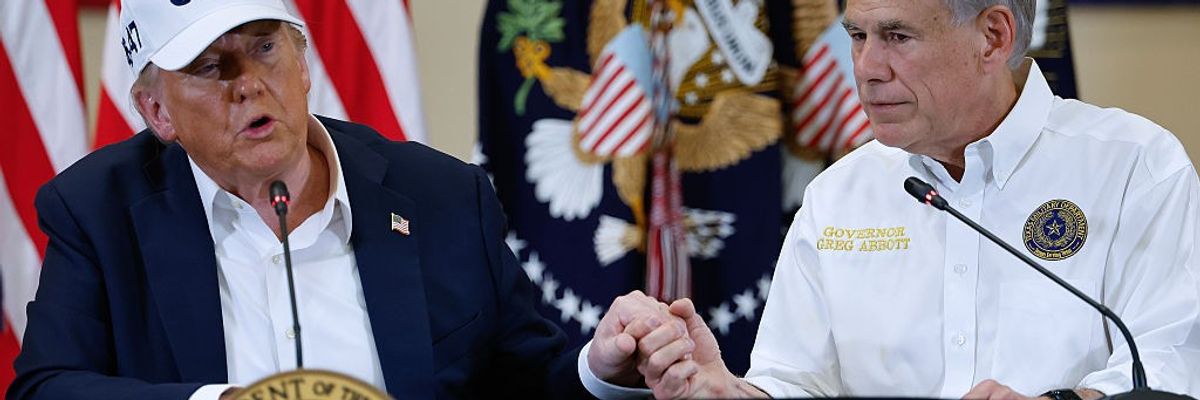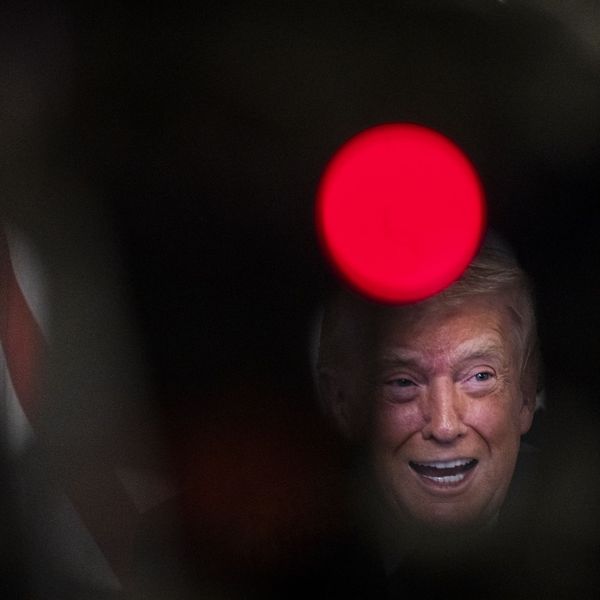
US President Donald Trump and Texas Gov. Greg Abbott hold hands during a round table event at the Hill Country Youth Event Center on July 11, 2025 in Kerrville, Texas.
Trump’s Desperate, Anti-Democratic Quest to Retain Power
Trump and his allies, selecting the voters likely to cast ballots for them is far better than letting all voters select their leaders.
US President Donald Trump and Republicans face a daunting challenge: How to preserve power in the wake of their wildly unpopular policies?
Their strategy is to intensify the GOP’s decades-long quest to limit voter participation. Selecting the voters likely to cast ballots for them is far better than letting all voters select their leaders.
Trump has taken the strategy to a whole new level. And he’s doing it out of fear and desperation.
Fighting History
During midterm elections, the president’s party loses seats in Congress. In Trump’s first term, Republicans lost 40 seats in the House in 2018. In 2010, President Barack Obama’s Democrats lost 63.
The exceptions are few and far between. In the aftermath of 9/11, President George W. Bush’s GOP gained eight House seats in 2002, but then lost 30 in 2006. In 1998, President Bill Clinton’s Democrats gained five seats, but that didn’t offset the 52 seats that they had lost in 1994. In all but three midterm elections from 1934 to 1994—from Franklin Roosevelt to Bill Clinton—the president’s party lost House seats. It did a little better in the Senate, gaining seats in only 6 of 23 midterm elections since 1934.
With Republicans holding a slim 219-212 majority heading into the 2026 midterms, Trump has every reason to panic at what awaits him in 15 months.
Fighting Democracy
Every 10 years, the Commerce Department conducts a census of the entire country. US census data is then used to apportion federal funding and representation in the House, as well as each state’s Electoral College votes. It’s also used by businesses, researchers, and community planners.
The next national redistricting will occur after the 2030 census. But Trump persuaded Republican Texas Gov. Greg Abbott to call a special session that would redraw congressional districts five years early to give Republicans five additional seats in Congress now.
According to the Texas Tribune, a majority of the Texas congressional delegation was wary of the idea, fearing that redistricting might spread their voters too thinly:
In discussions with Abbott’s office, White House staffers attempted to assuage his worries but were unsuccessful, according to two people with direct knowledge of the developments.
Enter Trump:
Then, Trump placed a call to Abbott during which they discussed redistricting. The governor subsequently agreed to put it on his agenda for the special session, according to two people who spoke with White House officials about the call, one of whom also discussed the matter with Abbott’s office.
Trump’s allies are now pushing other state governors to squeeze away Democratic seats in Florida, Indiana, South Carolina, and Missouri. In a 21st-century version of the Civil War, some Democratic governors in blue states are contemplating a response in kind.
Fighting Voters
Likewise, winning is easier for Republicans if they can systematically prevent likely Democratic voters from casting ballots at all. Trump is working that angle too. In March, he issued an executive order aimed at overhauling the nation’s voting system to favor the GOP. It takes direct aim at the US Constitution’s Elections Clause, which provides:
The Times, Places, and Manner of holding Elections for Senators and Representatives, shall be prescribed in each State by the Legislature thereof; but the Congress may at any time by Law make or alter such Regulations, except as to the Places of chusing [sic] Senators.
Five court cases challenging Trump’s order, which would prevent counting mail-in ballots received after election day and impose new voter registration requirements, are pending.
Fighting Progress
In his latest attack, Trump is railing against a problem that doesn’t exist: fraudulent votes. On August 18, he vowed to eliminate mail-in ballots and voting machines. On Truth Social he posted: “THE MAIL-IN BALLOT HOAX, USING VOTING MACHINES THAT ARE A COMPLETE AND TOTAL DISASTER, MUST END, NOW!!!”
In a press conference later that day, he added more lies:
Mail-in ballots are corrupt… You can never have a real democracy with mail-in ballots. And we as a Republican Party are going to do everything possible that we get rid of mail-in ballots. We’re going to start with an executive order that’s being written by the best lawyers in the country to end mail-in ballots because they’re corrupt.
Trump’s source for his false claims: Russian President Vladimir Putin. In an interview with Fox News, Trump said that Putin had agreed with him that the 2020 election had been rigged in favor of President Joe Biden: “He said, ‘Your election was rigged because you have mail-in voting,’” Trump quoted Putin as saying. “He said, ‘Mail-in voting, every election.’ He said, ‘No country has mail-in voting. It’s impossible to have mail-in voting and have honest elections.’”
There is no evidence that mail-in voting is corrupt. Thirty-four countries allow it, including Canada, Sweden, Switzerland, the United Kingdom, Australia, and Germany.
Those countries will be surprised to learn that they don’t have what Trump regards as “real democracy.”
But then again, America is rapidly losing what the rest of the world calls “real democracy.”
An Urgent Message From Our Co-Founder
Dear Common Dreams reader, The U.S. is on a fast track to authoritarianism like nothing I've ever seen. Meanwhile, corporate news outlets are utterly capitulating to Trump, twisting their coverage to avoid drawing his ire while lining up to stuff cash in his pockets. That's why I believe that Common Dreams is doing the best and most consequential reporting that we've ever done. Our small but mighty team is a progressive reporting powerhouse, covering the news every day that the corporate media never will. Our mission has always been simple: To inform. To inspire. And to ignite change for the common good. Now here's the key piece that I want all our readers to understand: None of this would be possible without your financial support. That's not just some fundraising cliche. It's the absolute and literal truth. We don't accept corporate advertising and never will. We don't have a paywall because we don't think people should be blocked from critical news based on their ability to pay. Everything we do is funded by the donations of readers like you. Will you donate now to help power the nonprofit, independent reporting of Common Dreams? Thank you for being a vital member of our community. Together, we can keep independent journalism alive when it’s needed most. - Craig Brown, Co-founder |
US President Donald Trump and Republicans face a daunting challenge: How to preserve power in the wake of their wildly unpopular policies?
Their strategy is to intensify the GOP’s decades-long quest to limit voter participation. Selecting the voters likely to cast ballots for them is far better than letting all voters select their leaders.
Trump has taken the strategy to a whole new level. And he’s doing it out of fear and desperation.
Fighting History
During midterm elections, the president’s party loses seats in Congress. In Trump’s first term, Republicans lost 40 seats in the House in 2018. In 2010, President Barack Obama’s Democrats lost 63.
The exceptions are few and far between. In the aftermath of 9/11, President George W. Bush’s GOP gained eight House seats in 2002, but then lost 30 in 2006. In 1998, President Bill Clinton’s Democrats gained five seats, but that didn’t offset the 52 seats that they had lost in 1994. In all but three midterm elections from 1934 to 1994—from Franklin Roosevelt to Bill Clinton—the president’s party lost House seats. It did a little better in the Senate, gaining seats in only 6 of 23 midterm elections since 1934.
With Republicans holding a slim 219-212 majority heading into the 2026 midterms, Trump has every reason to panic at what awaits him in 15 months.
Fighting Democracy
Every 10 years, the Commerce Department conducts a census of the entire country. US census data is then used to apportion federal funding and representation in the House, as well as each state’s Electoral College votes. It’s also used by businesses, researchers, and community planners.
The next national redistricting will occur after the 2030 census. But Trump persuaded Republican Texas Gov. Greg Abbott to call a special session that would redraw congressional districts five years early to give Republicans five additional seats in Congress now.
According to the Texas Tribune, a majority of the Texas congressional delegation was wary of the idea, fearing that redistricting might spread their voters too thinly:
In discussions with Abbott’s office, White House staffers attempted to assuage his worries but were unsuccessful, according to two people with direct knowledge of the developments.
Enter Trump:
Then, Trump placed a call to Abbott during which they discussed redistricting. The governor subsequently agreed to put it on his agenda for the special session, according to two people who spoke with White House officials about the call, one of whom also discussed the matter with Abbott’s office.
Trump’s allies are now pushing other state governors to squeeze away Democratic seats in Florida, Indiana, South Carolina, and Missouri. In a 21st-century version of the Civil War, some Democratic governors in blue states are contemplating a response in kind.
Fighting Voters
Likewise, winning is easier for Republicans if they can systematically prevent likely Democratic voters from casting ballots at all. Trump is working that angle too. In March, he issued an executive order aimed at overhauling the nation’s voting system to favor the GOP. It takes direct aim at the US Constitution’s Elections Clause, which provides:
The Times, Places, and Manner of holding Elections for Senators and Representatives, shall be prescribed in each State by the Legislature thereof; but the Congress may at any time by Law make or alter such Regulations, except as to the Places of chusing [sic] Senators.
Five court cases challenging Trump’s order, which would prevent counting mail-in ballots received after election day and impose new voter registration requirements, are pending.
Fighting Progress
In his latest attack, Trump is railing against a problem that doesn’t exist: fraudulent votes. On August 18, he vowed to eliminate mail-in ballots and voting machines. On Truth Social he posted: “THE MAIL-IN BALLOT HOAX, USING VOTING MACHINES THAT ARE A COMPLETE AND TOTAL DISASTER, MUST END, NOW!!!”
In a press conference later that day, he added more lies:
Mail-in ballots are corrupt… You can never have a real democracy with mail-in ballots. And we as a Republican Party are going to do everything possible that we get rid of mail-in ballots. We’re going to start with an executive order that’s being written by the best lawyers in the country to end mail-in ballots because they’re corrupt.
Trump’s source for his false claims: Russian President Vladimir Putin. In an interview with Fox News, Trump said that Putin had agreed with him that the 2020 election had been rigged in favor of President Joe Biden: “He said, ‘Your election was rigged because you have mail-in voting,’” Trump quoted Putin as saying. “He said, ‘Mail-in voting, every election.’ He said, ‘No country has mail-in voting. It’s impossible to have mail-in voting and have honest elections.’”
There is no evidence that mail-in voting is corrupt. Thirty-four countries allow it, including Canada, Sweden, Switzerland, the United Kingdom, Australia, and Germany.
Those countries will be surprised to learn that they don’t have what Trump regards as “real democracy.”
But then again, America is rapidly losing what the rest of the world calls “real democracy.”
US President Donald Trump and Republicans face a daunting challenge: How to preserve power in the wake of their wildly unpopular policies?
Their strategy is to intensify the GOP’s decades-long quest to limit voter participation. Selecting the voters likely to cast ballots for them is far better than letting all voters select their leaders.
Trump has taken the strategy to a whole new level. And he’s doing it out of fear and desperation.
Fighting History
During midterm elections, the president’s party loses seats in Congress. In Trump’s first term, Republicans lost 40 seats in the House in 2018. In 2010, President Barack Obama’s Democrats lost 63.
The exceptions are few and far between. In the aftermath of 9/11, President George W. Bush’s GOP gained eight House seats in 2002, but then lost 30 in 2006. In 1998, President Bill Clinton’s Democrats gained five seats, but that didn’t offset the 52 seats that they had lost in 1994. In all but three midterm elections from 1934 to 1994—from Franklin Roosevelt to Bill Clinton—the president’s party lost House seats. It did a little better in the Senate, gaining seats in only 6 of 23 midterm elections since 1934.
With Republicans holding a slim 219-212 majority heading into the 2026 midterms, Trump has every reason to panic at what awaits him in 15 months.
Fighting Democracy
Every 10 years, the Commerce Department conducts a census of the entire country. US census data is then used to apportion federal funding and representation in the House, as well as each state’s Electoral College votes. It’s also used by businesses, researchers, and community planners.
The next national redistricting will occur after the 2030 census. But Trump persuaded Republican Texas Gov. Greg Abbott to call a special session that would redraw congressional districts five years early to give Republicans five additional seats in Congress now.
According to the Texas Tribune, a majority of the Texas congressional delegation was wary of the idea, fearing that redistricting might spread their voters too thinly:
In discussions with Abbott’s office, White House staffers attempted to assuage his worries but were unsuccessful, according to two people with direct knowledge of the developments.
Enter Trump:
Then, Trump placed a call to Abbott during which they discussed redistricting. The governor subsequently agreed to put it on his agenda for the special session, according to two people who spoke with White House officials about the call, one of whom also discussed the matter with Abbott’s office.
Trump’s allies are now pushing other state governors to squeeze away Democratic seats in Florida, Indiana, South Carolina, and Missouri. In a 21st-century version of the Civil War, some Democratic governors in blue states are contemplating a response in kind.
Fighting Voters
Likewise, winning is easier for Republicans if they can systematically prevent likely Democratic voters from casting ballots at all. Trump is working that angle too. In March, he issued an executive order aimed at overhauling the nation’s voting system to favor the GOP. It takes direct aim at the US Constitution’s Elections Clause, which provides:
The Times, Places, and Manner of holding Elections for Senators and Representatives, shall be prescribed in each State by the Legislature thereof; but the Congress may at any time by Law make or alter such Regulations, except as to the Places of chusing [sic] Senators.
Five court cases challenging Trump’s order, which would prevent counting mail-in ballots received after election day and impose new voter registration requirements, are pending.
Fighting Progress
In his latest attack, Trump is railing against a problem that doesn’t exist: fraudulent votes. On August 18, he vowed to eliminate mail-in ballots and voting machines. On Truth Social he posted: “THE MAIL-IN BALLOT HOAX, USING VOTING MACHINES THAT ARE A COMPLETE AND TOTAL DISASTER, MUST END, NOW!!!”
In a press conference later that day, he added more lies:
Mail-in ballots are corrupt… You can never have a real democracy with mail-in ballots. And we as a Republican Party are going to do everything possible that we get rid of mail-in ballots. We’re going to start with an executive order that’s being written by the best lawyers in the country to end mail-in ballots because they’re corrupt.
Trump’s source for his false claims: Russian President Vladimir Putin. In an interview with Fox News, Trump said that Putin had agreed with him that the 2020 election had been rigged in favor of President Joe Biden: “He said, ‘Your election was rigged because you have mail-in voting,’” Trump quoted Putin as saying. “He said, ‘Mail-in voting, every election.’ He said, ‘No country has mail-in voting. It’s impossible to have mail-in voting and have honest elections.’”
There is no evidence that mail-in voting is corrupt. Thirty-four countries allow it, including Canada, Sweden, Switzerland, the United Kingdom, Australia, and Germany.
Those countries will be surprised to learn that they don’t have what Trump regards as “real democracy.”
But then again, America is rapidly losing what the rest of the world calls “real democracy.”

